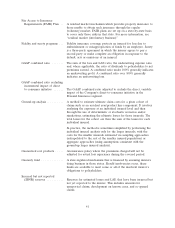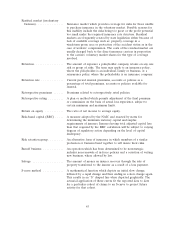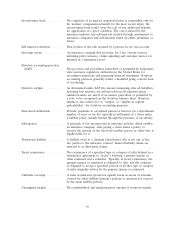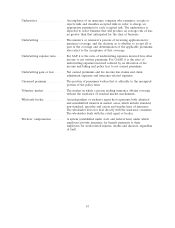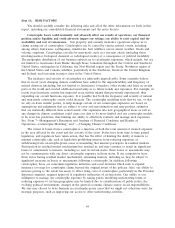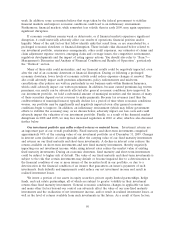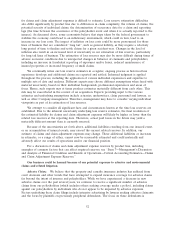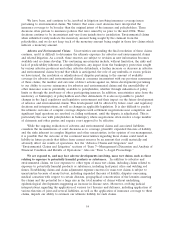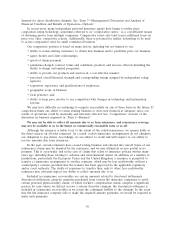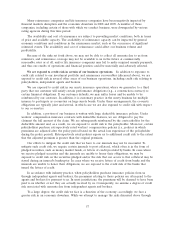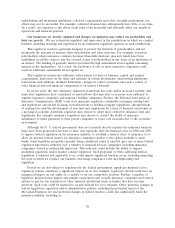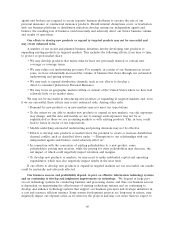Travelers 2009 Annual Report Download - page 63
Download and view the complete annual report
Please find page 63 of the 2009 Travelers annual report below. You can navigate through the pages in the report by either clicking on the pages listed below, or by using the keyword search tool below to find specific information within the annual report.we may realize reduced returns on these investments, we may incur losses on sales of these investments
and we may be required to write down the value of these investments, which could reduce our net
investment income and result in realized investment losses.
Our investment portfolio is also subject to increased valuation uncertainties when investment
markets are illiquid. The valuation of investments is more subjective when markets are illiquid, thereby
increasing the risk that the estimated fair value (i.e., the carrying amount) of the portion of the
investment portfolio that is carried at fair value as reflected in our financial statements is not reflective
of prices at which actual transactions could occur.
Our fixed maturity investment portfolio is invested, in substantial part, in obligations of states,
municipalities and political subdivisions (collectively referred to as the municipal bond portfolio).
Notwithstanding the relatively low historical rates of default on many of these obligations, during or
following an economic downturn, our municipal bond portfolio could be subject to a higher risk of
default or impairment due to declining municipal tax bases and revenue. The prolonged economic
downturn that began in 2008 has resulted in many states and local governments operating under
deficits or projected deficits. The severity and duration of these deficits could have an adverse impact
on the collectability and valuation of our municipal bond portfolio. In addition, some issuers may be
unwilling to increase tax rates, or to reduce spending, to fund maturing municipal bonds. Our portfolio
has also benefited from tax exemptions and certain other tax laws, including, but not limited to, those
governing dividends-received deductions and tax credits (such as foreign tax credits). Federal and/or
state tax legislation could be enacted in connection with deficit reduction or various types of
fundamental tax reform that would lessen or eliminate some or all of the tax advantages currently
benefiting us and could adversely affect the value of our investment portfolio.
Our investment portfolio includes residential mortgage-backed securities, collateralized mortgage
obligations, pass-through securities, and asset-backed securities collateralized by sub-prime mortgages;
commercial mortgage-backed securities; and wholly-owned real estate, real estate partnerships and
mortgage loans, all of which could be adversely impacted by further declines in real estate valuations
and/or financial market disruption.
Because of the risks set forth above, the value of our investment portfolio could decrease, we
could experience reduced net investment income, and we could incur realized investment losses, which
could materially and adversely affect our results of operations, financial position and/or liquidity.
If actual claims exceed our loss reserves, or if changes in the estimated level of loss reserves are
necessary, our financial results could be materially and adversely affected. Claims and claim
adjustment expense reserves (loss reserves) represent management’s estimate of ultimate unpaid costs
of losses and loss adjustment expenses for claims that have been reported and claims that have been
incurred but not yet reported. Loss reserves do not represent an exact calculation of liability, but
instead represent management estimates, generally utilizing actuarial expertise and projection
techniques, at a given accounting date. These loss reserve estimates are expectations of what the
ultimate settlement and administration of claims will cost upon final resolution in the future, based on
our assessment of facts and circumstances then known, reviews of historical settlement patterns,
estimates of trends in claims severity and frequency, expected interpretations of legal theories of
liability and other factors. In establishing reserves, we also take into account estimated recoveries from
reinsurance, salvage and subrogation.
The process of estimating loss reserves involves a high degree of judgment and is subject to a
number of variables. These variables can be affected by both internal and external events, such as
changes in claims handling procedures; adverse changes in loss cost trends, including inflationary
pressures in medical costs and auto and home repair costs; economic conditions including general
inflation; legal trends and legislative changes; and varying judgments and viewpoints of the individuals
involved in the estimation process, among others. The impact of many of these items on ultimate costs
51


